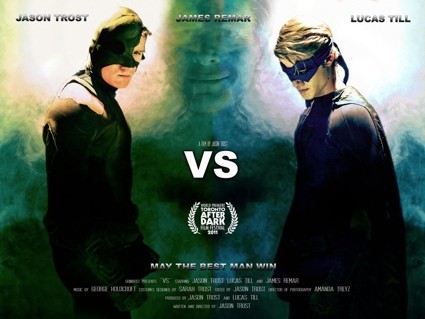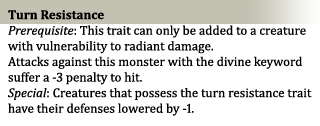These It Came from the DVR articles are going to be a little bit different. As an early Christmas present to myself, I picked up a festival pass to the Toronto After Dark film festival. So the first difference is that these are new movies, on the big screen, instead of old ones and niche programming on the small screen. The second difference is that these are going to be short. I’ve got eighteen films to see in seven days (as well as dressing up for the annual zombie walk), so I’m not going to have a whole lot of time to write, and I want post these while the blood is still fresh.
Toronto After Dark is a horror and genre film festival oozing with gobs of monster and rpg inspiration, but most of the films it showcases won’t see wide release – so in addition to extracting some rpg goodness from each movie, I’ll also give them a bit of a critique, so fellow gamers can know what they need to track down and what to avoid. I’ll try and keep spoilers to an absolute minimum.
VS
This superhero thriller jumps headfirst into the story, opening with former teammates Charge, Cutthroat, Shadow and the Wall kidnapped by their arch-nemesis Rickshaw. The four heroes awake in a small town, their powers nullified by a mysterious injection and the populace tied to clusters of high explosives. In order to save the trapped innocents, and themselves, they must complete a series of fiendish tests before Rickshaw detonates the bombs and obliterates the entire town.
Super Hero Action Meets Dark Thriller
VS is another ambitious indie film (I like this trend) that shoots for the moon. It stumbles, but there is genius there, and its sheer ballsy-ness makes me want to overlook the film’s shortcomings. Throwing superheroes into a Saw-esque thriller, is an idea worthy of the Joker (in spite of being a Marvel standard bearer, there are a few DC characters that I like) – so is writing, directing and starring in your film, but Jason Trost manages to pull it off without it looking like a vanity picture.
Because of the look of the costumes, it’s easy to compare VS to Kick-Ass. They may share some similarities, but they are as different as night and day. Both films draw on the ‘real-life superhero movement’ for aesthetic inspiration (hence the similar costumes), and both are a comment on the superhero genre. However, Kick-Ass is a spoof that throws superheroes into our world to send up the inherent ridiculousness of the entire genre (that’s not a slam against Kick-Ass – I happened to like it quite a bit), while VS is a straight superhero tale that draws on the language of horror films to showcase a truly sadistic villain.
And what a great villain to showcase. Veteran James Remar steals the show as Rickshaw, having fun with the role and making it crazy enough to be entertaining but keeping it this side of cartoony (a little over the top is fine – it is a superhero movie). In the Q+A Trost revealed that Remar is an old family friend and did the film as a favor (he liked the script too), which is a good thing for VS; because in the hands of someone the film could afford, I’m not sure the character would have worked.
The tests that Rickshaw puts the heroes through are fantastically evil, and as I mentioned, are very much in the tradition of Saw. There’s also a long tradition of these kinds of traps in comics, particularly the kind that involve difficult decisions that put the heroes’ morals in jeopardy – so the mixing of the two genres works perfectly and is the film’s real genius. Convoluted traps and villains toying with their prey seem completely at home in a superhero film without straining credibility (in fact, the audience expects it), while the dark and gritty horror film trappings tell the viewer that the stakes are much higher than a traditional comic book film and that the body count likely will be as well. This gives the characters’ actions a lot of weight and boosts the dramatic tension much more than you would expect from a film about superheroes.
VS’ second moment of genius, and the part of the film that makes it required viewing for any Hollywood director looking to adapt a comic book for the screen, is how Trost deals with the heroes’ backstory. Instead of spending the first half of the film detailing how the characters acquired their powers, and formed their team, VS just cuts to the interesting part of the story (waking up powerless in a town filled with deadly traps) and trusts that the audience is smart enough to fill in the blanks as the story unfolds. Through short flashbacks and character chatter we’re given all we need to know without lots of boring exposition and wasted screen-time. With VS, Trost proves once and for all that it is possible to make an exciting superhero film right out of the gate.
With the low budget Trost wisely wrote out the costly use of superpowers, and relied entirely on practical effects and stunt work. Normally I would have wanted to at least see someone fly or lift up a car in a comic book movie, but the low-fi look really fits with the dark and grimy atmosphere of the film.
Where VS stumbles is in the film’s pacing. Each of the tests is timed, and the heroes must race against the clock to both overcome the challenges and find Rickshaw before the countdown expires and the whole town blows up. That’s a great device to create natural tension, but unfortunately, every time the viewer starts to worry VS shoots itself in the foot by having its characters get into a drawn out conversations and arguments. There were times when I felt like yelling at the screen, “at least walk and talk, you’re all going to die!” I couldn’t help but wonder as the horrible consequences of the countdown unfolded, that it all could have been avoided if the characters hadn’t been so chatty.
VS is recommended for superhero fans, especially those that are ready for a fresh take on the genre. If, like me, you‘re also a fan of horror films, then VS is happily a chocolate and peanut butter situation. It isn’t perfect, but the high points of VS are well worth the lows.
RPG Goodness
If you play a superhero rpg and want to run a game with the grittiness of the Punisher, but prefer costumes to guns, then VS is the best guidebook you can find. I can totally picture combining the D20 version of Mutants and Masterminds with the list of traps from the Dungeon Master’s Guide to create an adventure very similar to the scenario in the film. Even though the movie doesn’t contain any supernatural elements, I think VS would also work as an introduction to set the tone for a mash-up of Palladium’s Beyond the Supernatural and Heroes Unlimited (I’m not sure if anyone has ever played that – but now that I mention it I kind of want to try it out).
Outside of the film’s obvious inspiration for superhero rpgs, I think that VS highlights an issue in D&D that has been dealt with very differently across the editions of the game – nullifying PC powers. While I don’t think there are any adventures that feature the PCs getting injected with a potion that prevents them from using their abilities, many of the old-school modules are filled with walls that can’t be climbed by Thieves, damage that can’t be healed by the Cleric, and lists of spells that Magic Users are barred from casting to bypass an obstacle (the classic adventure Tomb of Horrors is big on this). Starting with 3e, this kind of adventure design was frowned on and often criticised. DMs were encouraged to work with a PC’s powers rather than work around them. When it comes to this issue I am unapologetically in the camp of the new school. Having your character’s abilities hamstrung just so an adventure can railroad your actions is not fun. I would just as soon have choices I can’t use removed from the game rather than have the illusion of choice.
As strong as my stance is on negating PCs’ powers in adventure design, when it comes to monsters I feel differently. I love the beholder’s anti-magic cone, a ghast’s resistance to turning and the thought eater’s special attacks against psionic characters -even though all these creatures nullify class powers in their own way. This might seem hypocritical, but I think the difference between a monster and an adventure is that the monsters in these cases are rare (although if you had an adventure with nothing but ghasts it wouldn’t be much fun for the cleric – or anyone really), their powers are discreet, and rather than reducing a character’s options to a single path (you can’t pick that lock or use a knock spell, you have to find the magic key in room 18 to proceed), these monsters interact with each of the classes in a unique way that makes them frightening and interesting (a golem is immune to most spells, but a few thematic ones affect it in unique ways).
In 4e, which introduced the concept of power sources, this is the feature I expected to interact with those classic monsters, an exciting possibility I thought was wasted (as it turns out, power sources weren’t used for much of anything) – something I’ve lamented before. To remedy this, I’ve created a sampling of traits that can be added to monsters that can transform them into ‘kryptonite’ for certain classes.
Power Sources and Monsters
The following traits can be added to a monster to modify the way the creature interacts with the power sources of the PCs. These traits are minor enough that adding one as-is shouldn’t alter a monster’s level or experience value, although in certain powerful combinations you may instead use it to replace an existing trait or power. Care should be used in placing these traits – there is little point giving a monster anti-magic shell, if there are no arcane characters in the party and the turning class feature will seem pointless if every undead opponent the party encounters has turn resistance.
Tags: 4e, Blather, Comics, D&D, Pop Culture


